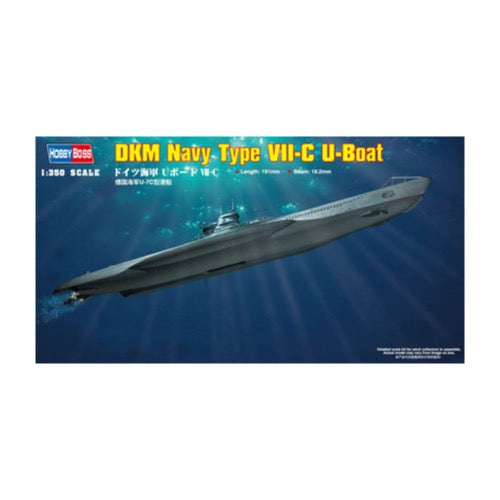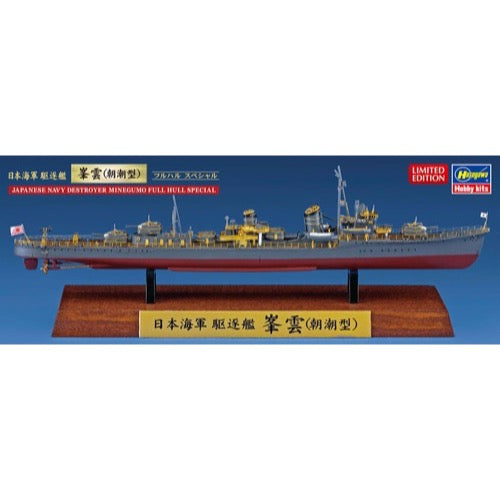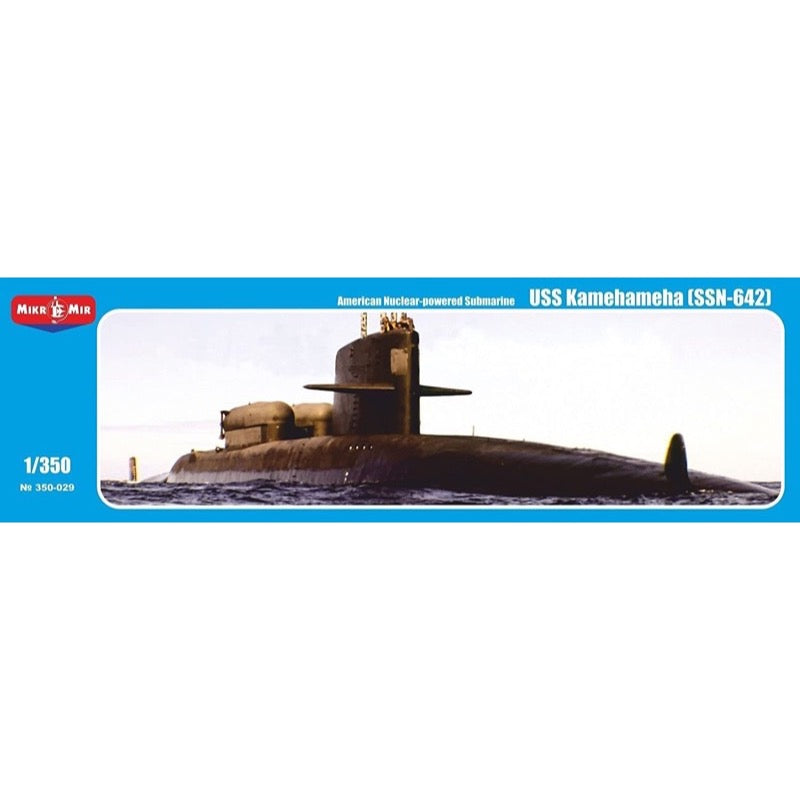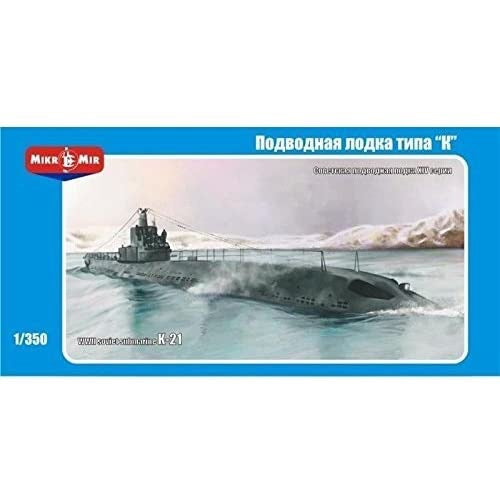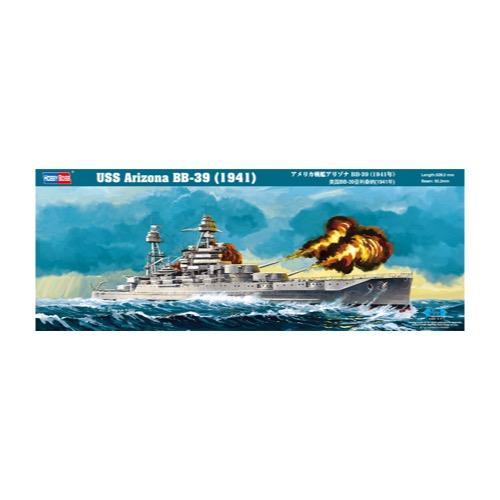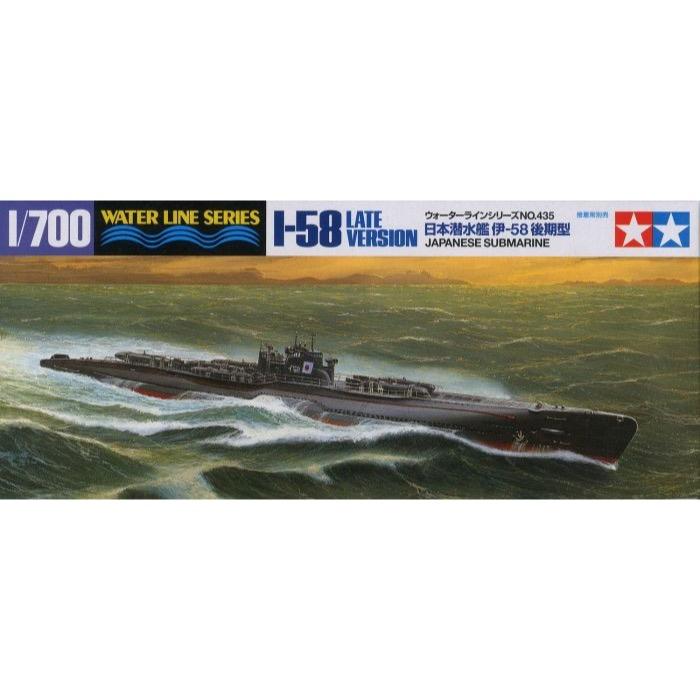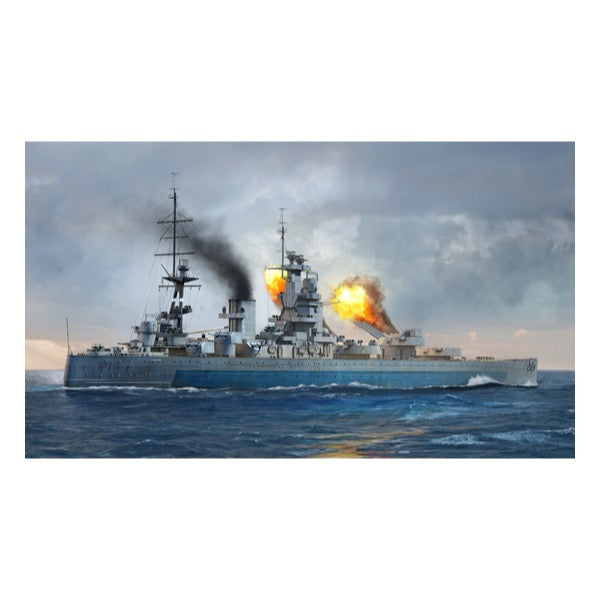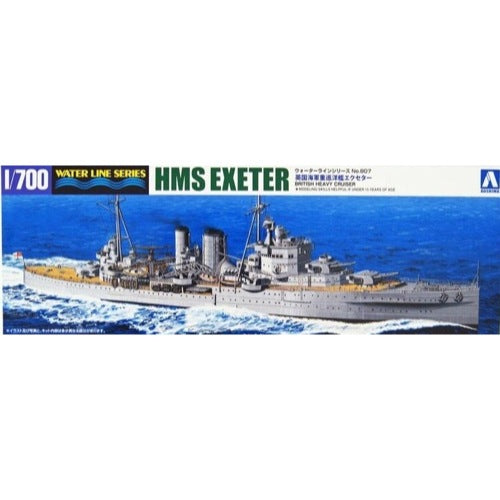
Aoshima A005273 1/700 British Heavy Cruiser Exeter
HMS Exeter (68) was a British heavy cruiser of the interwar period and World War II. The keel was laid for this unit in 1928, the launch took place in July 1929, and the entry into service with the Royal Navy - in 1931. The total length of the ship at the time of launching was 175.3 meters, total width 17.7 meters, and full displacement - about 10,600 tons. The maximum speed was around 31 knots. The on-board armament at the outbreak of World War II included, among others: 6 203 mm guns, 4 102 mm guns and 2 40 mm cannons. The unit could operate two seaplanes.
HMS Exeter (68) was one of the British York-class heavy cruisers. Cruisers of this type arose as the de facto modernized and reduced County class. Compared to her, they had, above all, weaker weapons, but still had good performance and high seaworthiness. They were also characterized by better armor - especially artillery turrets - and a much better layout of the space on the ship, especially in the bow superstructure. In general, York-class cruisers were viewed as successful units with considerable combat value. In the interwar period, HMS Exeter served in the Caribbean Sea, the Mediterranean Sea and the South Atlantic. His combat career in World War II began very fruitfully, because in December 1939 he took part in the battle at the mouth of the La Plata River, as a result of which the German pocket battleship Admiral Graf Spee was sunk. As a result of this battle, however, it suffered serious damage and was under renovation until the beginning of 1941! At the end of that year, he was sent to the Far East, and in 1942 he took part in the Battle of the Java Sea, as a result of which he was sunk, on March 1 this year.
The Exeter was commissioned in 1931 as a York-class heavy cruiser in accordance with the Royal Navy's plans in the 1920s. She became the last cruiser to be armed with 203mm guns due to the London Naval Treaty. She was also equipped with 2 aircraft catapults. After the outbreak of war, Exeter confronted the German heavy cruiser Admiral Graf Spree at the Battle of the River Plate and contributed to the victory.
Between 1940 and 41, she was modified with anti-aircraft guns, and upon returning to the fleet, was put on escort missions in the Atlantic before being transferred to the Pacific. At the Battle of Java Sea, Exeter engaged the IJN fleet and was sunk on March 1, 1941, after a fierce battle.
This kit builds a water line model.
This is an injection-plastic ship model kit.
Includes
- Decals
Mold Color
- Grey, brown (deck)
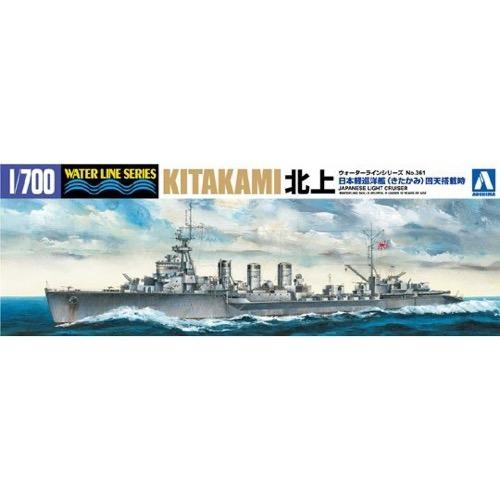
Aoshima A005132 1/700 Light Cruiser Kitakami Kaiten Carrier
Ordered in 1917 to the Sasebo Naval Arsenal and completed in April 1921 as the 4th vessel of the Harima-class cruisers, Kitakami was converted into a torpedo cruiser. She subsequently participated in the Battle of Midway as part of the Aleutian screening force. She was later used as a fast transport and made numerous sorties to Rabaul and other locations in the Solomon Islands and New Guinea. After taking severe damage in a torpedo attack by the submarine HMS Templar on 27 January 1944, she was converted to a Kaiten human torpedo carrier. She survived the war, and was used as a tender for repatriation vessels after the war.
Kitakami was a Japanese light cruiser whose keel was laid in 1919, launched in July 1920, and commissioned in the Imperial Japanese Navy in April 1921. The length of the ship at the time of launching was 152.4 m, width 14.2 m, and her displacement was 5,200 tons. The cruiser Kitakami's maximum speed was 36 knots. At the time of launching, the main armament was 7 140 mm guns in single positions, and the additional armament was, among others: 2 80 mm cannons and 8 533 mm torpedo tubes.
Kitakami was the third Kuma-class cruiser. Cruisers of this type were in fact the enlarged Tenryu class, but had greater range, speed, and better weapons, with the exception of anti-aircraft weapons, which were still very weak. From August 1944 to January 1945 Kitakami was converted into a torpedo cruiser - the number of guns was reduced to three and the number of torpedo tubes increased to 40! The modernized cruiser could also use Kaiten-class suicide torpedoes. The combat career of the cruiser Kitakami began during the Sino-Japanese fighting in the 1930s. The Kitakami combat trail in World War II began in December 1941 with the escorting of a team of battleships on the route from Hashirijama port to the Bonin Islands. In May 1942, he took part in the seizure of the Aleutians. From the second half of 1942, he began to play the role of a fast transport ship, serving in this role, among others in the region of the Solomon Islands and New Guinea until 1944. After the already signaled conversion to the torpedo cruiser Kitakami, it did not take part in major operations in the Pacific, although it was damaged as a result of air attacks. The cruiser survived the war and was scrapped until March 1947.
Parts come molded in grey, with some clear parts, and decals included.
This is an injection-plastic ship model kit.
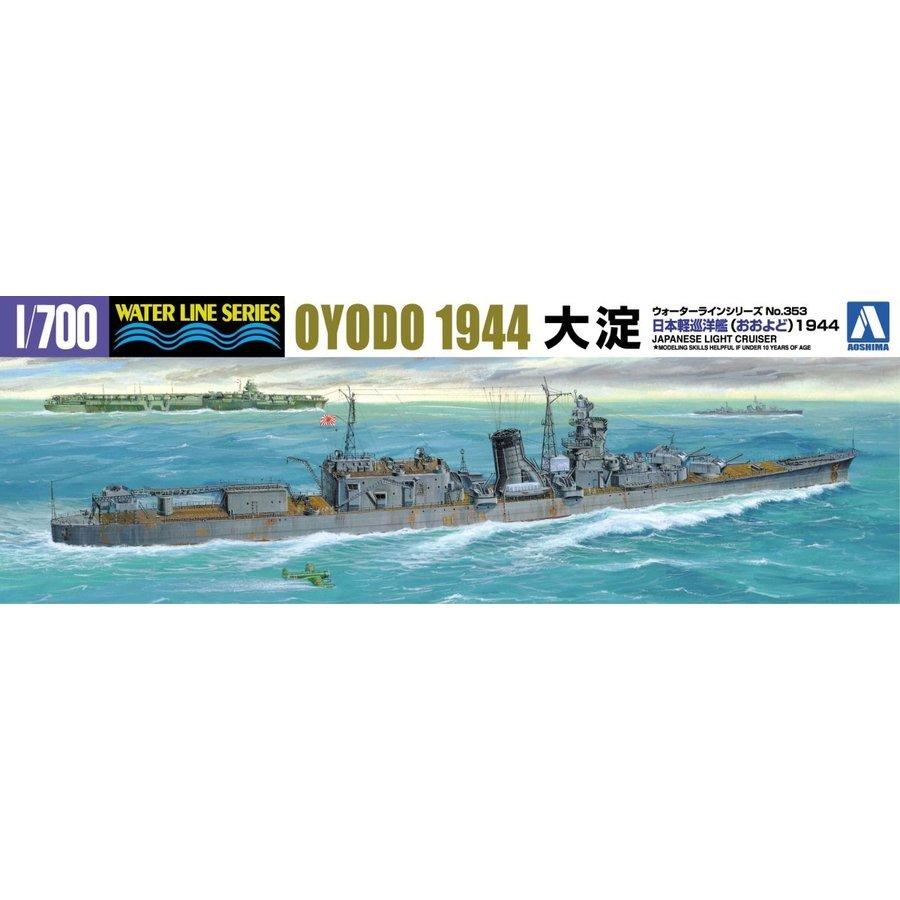
Aoshima A004540 1/700 I.J.N. Light Cruiser Oyodo 1944
Oyodo was a Japanese light cruiser of the Second World War. The keel for this unit was laid in 1941, the launch took place in April 1942, and the entry into service - in 1943. The length of the ship was 192 meters and a width of 15.7 meters. Full displacement reached approx. 11,400 tons, and maximum speed - approx. 34 knots. The deck armament, at the time of launching, consisted of: 6 155 mm guns, 8 100 mm AA guns and 18 25 mm cannons. Until 1944, the unit could operate six seaplanes.
The Oyodo was built as the only unit of its class. It was designed as the flagship of a squadron of submarines that interacted with the main surface forces of the fleet. It places emphasis on a large swimming range, considerable autonomy, possibly large reconnaissance and reconnaissance possibilities as well as extensive communication equipment. Finally, a very unusual light cruiser was created, equipped with as many as 6 seaplanes, but with relatively weak main armament. It also differed from other ships of this type in the Japanese Navy by the lack of torpedo tubes. Oyodo, shortly after entering service, was directed to the Truk base in the Carolingian archipelago, but in February 1944 it returned to its mother waters. In the period of March-April 1944, the Oyodo underwent modernization, which included: strengthening the anti-aircraft armament, dismantling parts of the seaplane service equipment and installing a new Type 22 radar. The unit thus modernized took part in the Battle of Leyte Bay in October 1944 year where it was slightly damaged. The unit was sunk in an air attack at the Kure naval base on July 28, 1945.
Aoshima's 1/700-scale "Waterline" series model kit of the Japanese Navy light cruiser Oyodo, with its characteristic large aircraft hangar renovated into a communications headquarters room, has been renewed with more precision! The parts structure is simple and easy to assemble for accurate reproduction; in addition to various equipment such as anti-aircraft guns, catapults and electric probes, a newly designed carrier-based aircraft has been added. Some of the parts are slide-molded for density and precision; in addition to armaments such as destroyer main guns and machine guns, carrier-based aircraft and various equipment have been updated. The outfitting parts (Type 96 25mm triple machine gun, direction finder antenna, No. 22 electric probe, No. 13 electric probe, Type 94 shooting device, 90cm signal searchlight, 110cm signal searchlight, Kure type 2 type 5 injection machine (aircraft catapult), 11m internal fire launch, 11m fire boat, 9m cutter, and Type 0 water reconnaissance aircraft) have been renewed with new molds.
This is an injection-plastic ship model kit.
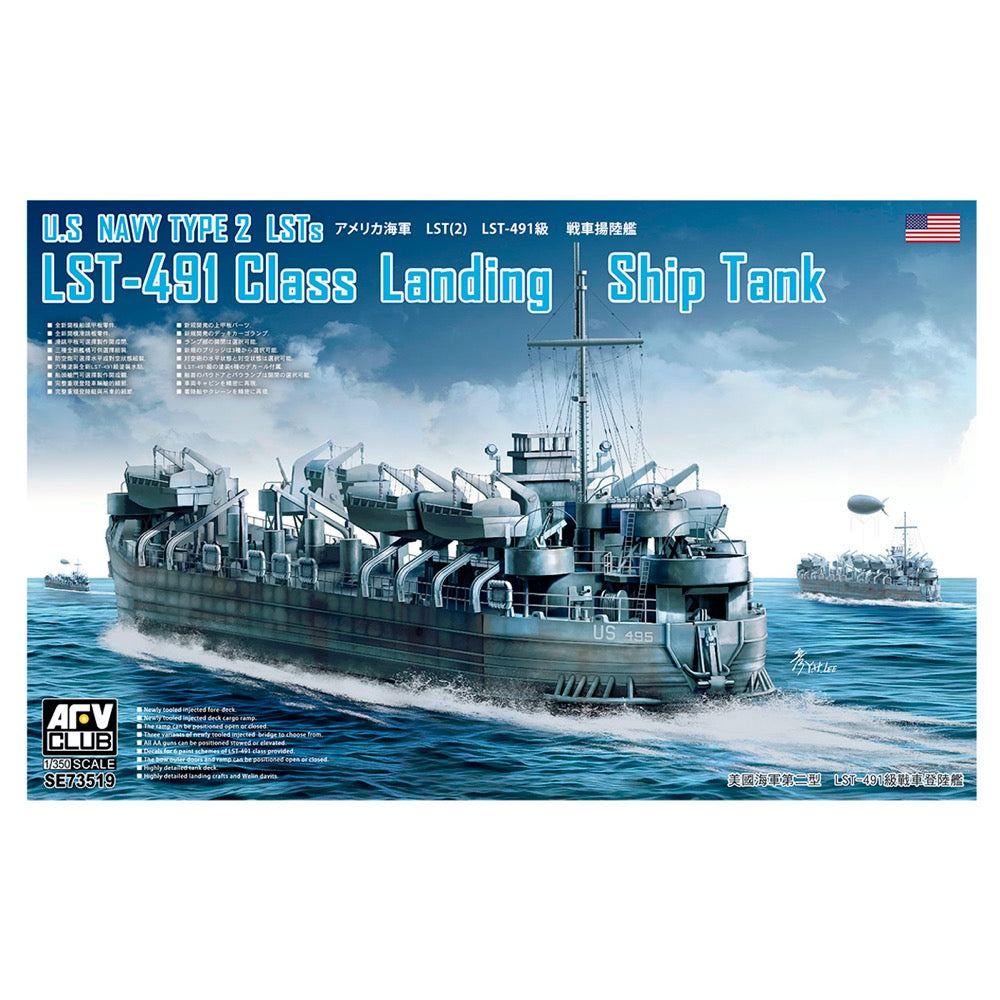
AFV SE73519 1/350 LST-491 Class
This kit from AFV Club is a new mold! The LST-491-class tank landing ship was commissioned by the U.S. Navy in World War II, and by adopting hinged ramps, it enabled the quick and efficient transportation of vehicles and supplies; it was pivotal to the Normandy landing operation. AFV Club's kit precisely reproduces both the exterior and the interior of this vehicle, with both the bow door and lamp able to be opened and closed after assembly. All of the AA guns can be positioned in horizontal or anti-aircraft positions. You can select to assemble it with any of three types of bridge, too.
Features
- Newly-tooled bow foredeck section.
- Newly-tooled vehicle ramp connecting the main deck and third deck.
- The ramp can be positioned in closed or lowered position.
- Three variants of newly-tooled bridges to choose from.
- All AA guns can be positioned in horizontal or anti-aircraft position.
- Decals for 6 different LST-491 class boats included.
- The bow outer doors can be positioned open or closed.
- Highly-detailed tank and vehicle deck.
- Highly-detailed Higgins Boats and Welin davits system.


